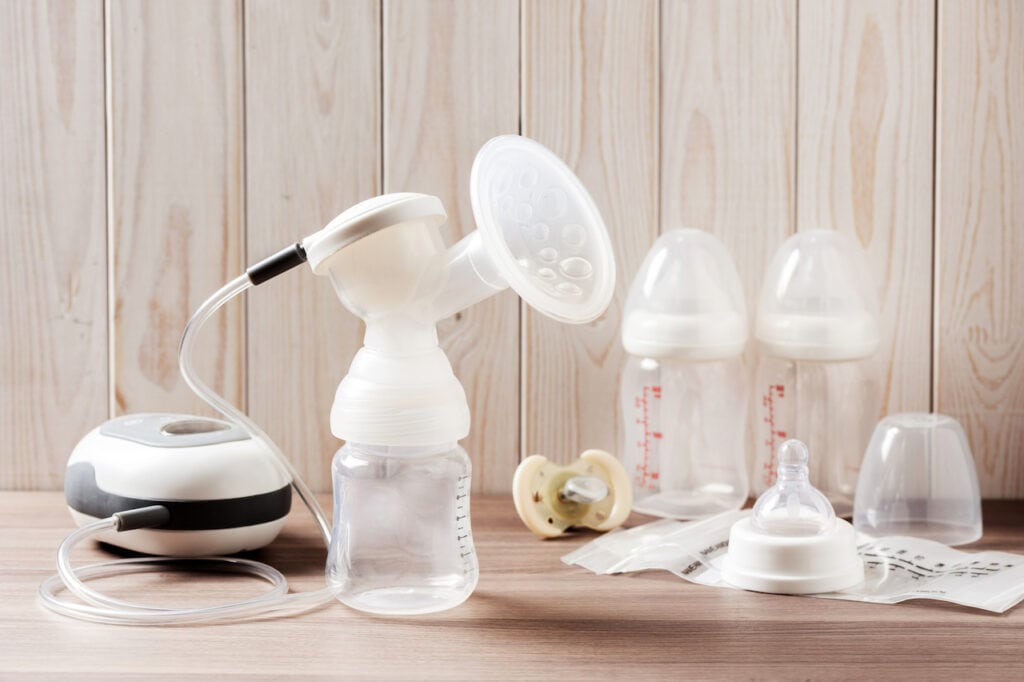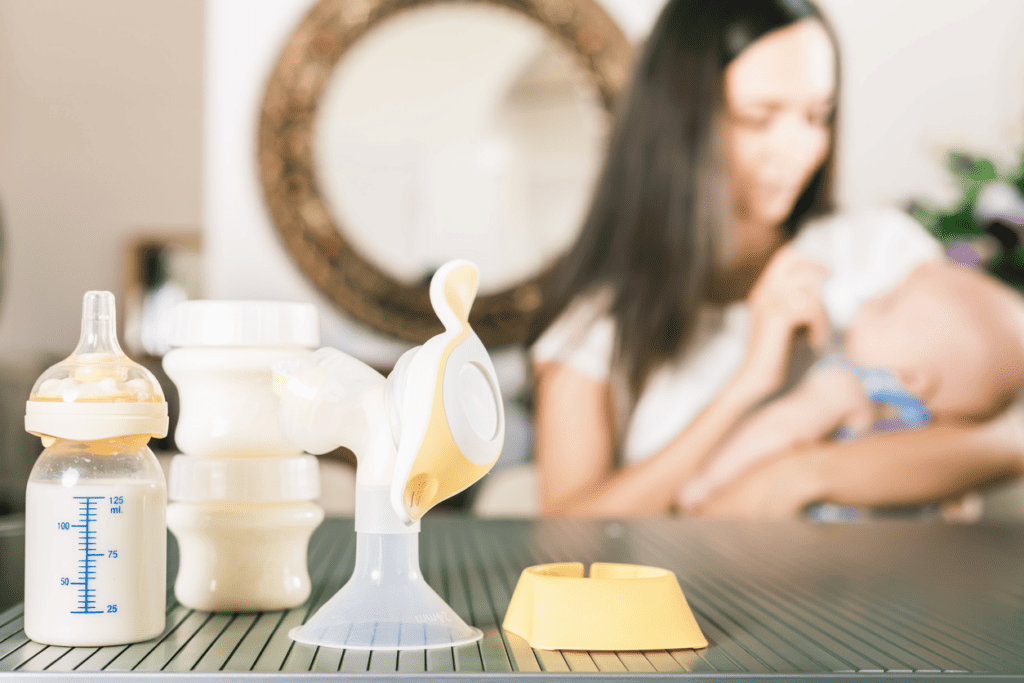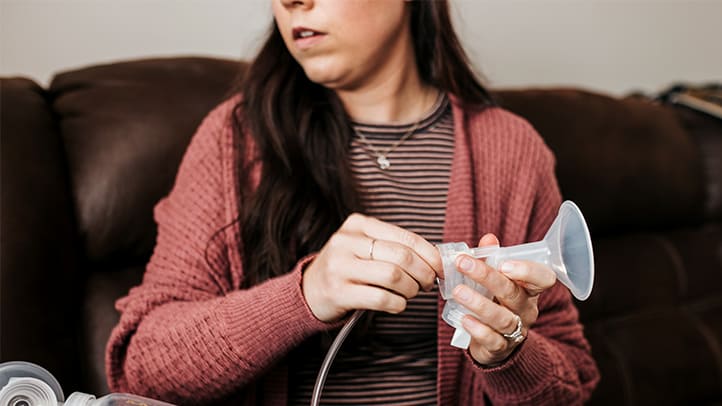Purple nipples after pumping can be a cause for concern for breastfeeding mothers. The phenomenon is not uncommon and can be caused by a variety of factors.
Understanding the reasons behind purple nipples after pumping is essential in identifying potential solutions.
Breast pumping is a common practice for many mothers who are unable to breastfeed their babies directly. However, some women may experience purple nipples after pumping, which can be a sign of a problem.
While the condition is not always serious, it is important to understand the potential causes and seek appropriate treatment if necessary.
Key Takeaways
- Purple nipples after pumping can be caused by a variety of factors
- Consulting a lactation consultant can help identify potential solutions
- Maintaining proper breast pumping techniques and addressing lifestyle factors may help prevent purple nipples after pumping.
Understanding the Phenomenon of Purple Nipples After Pumping

Purple nipples after pumping are a common occurrence among lactating mothers. This phenomenon is also known as nipple discoloration or discoloration of the nipple during pumping. It can be alarming for new mothers, but it is generally not a cause for concern.
The discoloration occurs due to the pressure applied on the nipples during pumping. The suction of the pump causes the blood vessels in the nipple to constrict, leading to a temporary lack of blood flow. As a result, the nipple may turn purple or blue.
It is important to note that this discoloration is temporary and will typically resolve on its own within a few minutes to a few hours. However, if the discoloration persists for an extended period or is accompanied by pain or other symptoms, it is advisable to consult a healthcare provider.
To prevent nipple discoloration during pumping, it is recommended to use a breast pump with adjustable suction levels. This allows the mother to control the pressure applied to the nipples and minimize the risk of discoloration.
In summary, nipple discoloration, or purple nipples after pumping, is a common phenomenon among lactating mothers. It occurs due to the pressure applied to the nipples during pumping and is generally not a cause for concern.
However, if the discoloration persists or is accompanied by pain or other symptoms, it is advisable to seek medical attention.
The Role of Breast Pumping
Breast pumping is a common practice among new mothers who want to provide their babies with breast milk. While breast pumping can be an effective way to increase milk supply and provide milk for a baby when the mother is away, it can also lead to nipple purple after pumping.
Breast pumping involves the use of a breast pump, which creates suction to extract milk from the breast. The breast pump consists of a motor, tubing, and a flange or breast shield. The flange is the part of the breast pump that is placed over the breast and creates a seal around the nipple.
The suction created by the breast pump can cause nipple purple after pumping, especially if the suction is too strong or if the mother pumps for a prolonged time. Over-pumping can also lead to nipple purple after pumping.
It is important to ensure that the breast pump is placed correctly and that the flange is the correct size. Using the wrong flange size or a flange that is too small can cause nipple purple after pumping.
In summary, breast pumping can be an effective way to provide breast milk for a baby, but it can also lead to nipple purple after pumping. It is important to use the breast pump correctly, use the correct flange size, and avoid over-pumping to prevent nipple purple after pumping.
Potential Causes of Purple Nipples After Pumping

Purple nipples after pumping can be a cause for concern for many breastfeeding mothers. In most cases, purple nipples are not a serious issue and can be easily resolved.
However, it is important to understand the potential causes of purple nipples after pumping to ensure proper treatment.
Vasospasm
Vasospasm is a condition in which the blood vessels in the nipples constrict, causing reduced blood flow to the area. This can result in purple or bluish nipples. Vasospasm can be caused by exposure to cold temperatures, stress, or smoking.
Raynaud’s Phenomenon
Raynaud’s phenomenon is a condition in which the blood vessels in the nipples spasm, causing reduced blood flow to the area. This can result in purple or bluish nipples. Raynaud’s phenomenon can be caused by exposure to cold temperatures, stress, or smoking.
Nipple Vasospasm
Nipple vasospasm is a condition in which the blood vessels in the nipples constrict, causing reduced blood flow to the area. This can result in purple or bluish nipples. Nipple vasospasm can be caused by exposure to cold temperatures, stress, or smoking.
Bruise
A bruise can occur on the nipple after pumping if the breast shield is too tight or if the suction is too strong. This can cause purple or bluish discoloration of the nipple.
Thrush
Thrush is a fungal infection that can occur in the breast tissue. It can cause nipple pain, redness, and purple or bluish discoloration of the nipple.
Yeast Infection
A yeast infection can occur in the breast tissue and can cause nipple pain, redness, and purple or bluish discoloration of the nipple.
Mastitis
Mastitis is an infection of the breast tissue that can cause nipple pain, redness, and purple or bluish discoloration of the nipple.
Mammary Constriction Syndrome
Mammary constriction syndrome is a condition in which the milk ducts in the breast become compressed, causing reduced milk flow and nipple pain. This can also cause purple or bluish discoloration of the nipple.
Engorgement
Engorgement occurs when the breasts become overly full with milk. This can cause nipple pain and purple or bluish discoloration of the nipple.
Plugged Ducts
Plugged ducts occur when milk ducts in the breast become blocked. This can cause nipple pain and purple or bluish discoloration of the nipple.
Oversupply of Breast Milk
An oversupply of breast milk can cause nipple pain and purple or bluish discoloration of the nipple. This occurs when the breast produces more milk than the baby needs.
In conclusion, purple nipples after pumping can be caused by a variety of factors, ranging from minor issues like bruising and engorgement to more serious conditions like mastitis. It is important to consult with a healthcare provider if the discoloration persists or is accompanied by other symptoms.
The Impact of Breastfeeding and Nursing
Breastfeeding and nursing are natural processes that provide numerous benefits to both the mother and baby. However, it is not uncommon for nursing mothers to experience nipple purple after pumping, which can be concerning for new moms.
In this section, we will explore the impact of breastfeeding and nursing on nipple health, as well as some tips for preventing nipple purple after pumping.
Breastfeeding and nursing involve the baby latching onto the mother’s breast and sucking milk. The areola, the darker area surrounding the nipple, is also involved in the process. When the baby latches on properly, the nipple and areola are drawn into the baby’s mouth, and the baby begins to suckle.
This process can sometimes cause soreness or discomfort, especially if the latch is not correct.
Breastfeeding positions can also have an impact on nipple health. It is important to find a comfortable position that allows the baby to latch on properly and suckle effectively. Some common breastfeeding positions include the cradle hold, football hold, and side-lying position.
Chestfeeding, which is breastfeeding for transgender men, can also involve different positions that may be more comfortable for the mother.
If the baby has a bad latch, it can lead to nipple soreness and even nipple damage. It is important to ensure that the baby is latching on correctly and sucking effectively.
If the baby is having difficulty latching on, a lactation consultant or healthcare provider can provide guidance and support.
Exclusive pumping, which involves using a breast pump to express milk, can also impact nipple health. It is important to use a breast pump that fits properly and does not cause discomfort or damage to the nipple.
Additionally, taking breaks and using different pumping positions can help prevent nipple purple and other issues.
In summary, breastfeeding and nursing have numerous benefits for both the mother and baby. However, it is important to take steps to prevent nipple purple and other nipple health issues.
Finding a comfortable breastfeeding position, ensuring proper latch, and using a properly fitting breast pump can all help prevent nipple purple after pumping.
Consulting a Lactation Consultant

If a mother experiences nipple purple after pumping, it is recommended to consult with a lactation consultant. Lactation consultants are professionals who specialize in helping mothers with breastfeeding and lactation issues. They have the knowledge and expertise to assess the situation and provide guidance on how to alleviate the problem.
The lactation consultant will first assess the mother’s breastfeeding technique to ensure that the baby is latching on properly. They will also check for any underlying medical conditions that may be causing the nipple purple, such as Raynaud’s phenomenon or thrush.
The lactation consultant may also recommend changes to the mother’s pumping routine or the use of different equipment to alleviate the problem.
In addition to providing guidance on how to alleviate nipple purple, lactation consultants can also provide support and encouragement to mothers who may be struggling with breastfeeding. They can offer advice on how to increase milk supply, deal with engorgement, and manage other common breastfeeding issues.
Overall, consulting with a lactation consultant can be a valuable resource for mothers who are experiencing nipple purple after pumping. They can provide expert guidance and support to help mothers continue to breastfeed successfully.
Role of Pregnancy and Medications
Nipple purple after pumping can be caused by a variety of factors, including pregnancy and certain medications. During pregnancy, the body undergoes significant changes that can affect the breasts and nipples. As a result, women may experience nipple purple after pumping or breastfeeding.
Estrogen, a hormone that increases during pregnancy, can also cause changes in breast tissue, including increased blood flow. This increased blood flow can cause the nipples to appear purple or blue after pumping or after breastfeeding.
Certain medications can also cause nipple purple after pumping. Vitamin B6, which is often taken as a supplement during pregnancy, can cause vasodilation, or widening of blood vessels, which can lead to nipple purple.
Acetaminophen and ibuprofen, commonly used pain relievers, can also cause vasodilation and contribute to nipple purple.
It is important for women to discuss any medications they are taking with their healthcare provider, especially during pregnancy and breastfeeding. Healthcare providers can help determine if a medication is safe to take and can provide guidance on managing potential side effects.
In summary, pregnancy and certain medications can contribute to nipple purple after pumping. Women should be aware of the potential side effects of medications and discuss any concerns with their healthcare provider.
Lifestyle Factors and Purple Nipples
There are a number of lifestyle factors that can contribute to nipple purple after pumping. Some of the most common factors include caffeine, nicotine, and family history.
Caffeine is a stimulant that can cause blood vessels to constrict, which can lead to decreased blood flow to the nipples. This can result in purple or discolored nipples after pumping. If you are experiencing this issue, it may be helpful to reduce your caffeine intake or avoid caffeine altogether.
Nicotine is another factor that can contribute to nipple discoloration. Smoking or using other tobacco products can cause blood vessels to constrict and reduce blood flow to the nipples, leading to purple or discolored nipples after pumping. If you are a smoker, quitting smoking may help to alleviate this issue.
Family history can also play a role in nipple discoloration after pumping. If you have a family history of purple or discolored nipples, you may be more likely to experience this issue yourself.
While there is no way to change your genetics, being aware of this risk factor can help you to better understand why you may be experiencing nipple discoloration after pumping.
Overall, there are a number of lifestyle factors that can contribute to nipple purple after pumping. By understanding these factors and taking steps to address them, you can help to alleviate this issue and ensure that your pumping experience is as comfortable and effective as possible.
Home Remedies and Treatments
In cases where nipple purple after pumping is caused by discomfort or pain, home remedies and treatments can be effective. Here are some options to consider:
Warm Compresses
Applying a warm compress to the affected area can help to increase blood flow and reduce pain and discomfort. This can be done by soaking a washcloth in warm water and placing it on the nipple for several minutes at a time.
Olive Oil
Olive oil is a natural moisturizer that can help to soothe and heal the skin. Applying a small amount of olive oil to the nipple after pumping can help to reduce pain and discomfort, and may also help to prevent nipple purple.
Probiotics
Taking probiotics can help to promote healthy bacteria in the body, which can help to prevent infections and reduce inflammation. This can be especially helpful for women who are prone to nipple pain or discomfort after pumping.
Avoiding Tight Clothing
Wearing tight clothing can put pressure on the nipples, which can lead to pain and discomfort. To prevent nipple purple after pumping, it is important to wear loose-fitting clothing that allows for proper airflow.
Rest and Relaxation
Resting and relaxing can help to reduce stress and tension in the body, which can help to prevent nipple pain and discomfort. Taking time to rest and relax after pumping can also help to promote healing and reduce the risk of nipple purple.
Overall, there are many home remedies and treatments that can be effective for preventing and treating nipple purple after pumping. By incorporating these options into your daily routine, you can help to promote healing and reduce the risk of nipple pain and discomfort.
Maintaining Breast Milk Supply
Maintaining breast milk supply is crucial for breastfeeding mothers, especially those who are pumping milk for their babies. A decrease in milk supply can be caused by various factors, including stress, illness, and inadequate pumping.
Therefore, it is essential to take steps to ensure that milk production remains consistent.
One of the most effective ways to maintain milk supply is to pump regularly. Breast milk supply works on a supply and demand basis, meaning that the more milk is removed from the breasts, the more milk the body will produce.
Therefore, it is recommended that mothers pump every 2-3 hours, or at least 8-10 times per day.
In addition to regular pumping, it is also important to ensure that the breasts are adequately emptied during each pumping session. This means pumping until the milk flow slows down and then continuing for a few more minutes to ensure that the breasts are fully drained.
Mothers can also try power pumping, which involves pumping for shorter periods with shorter breaks in between to stimulate milk production. This technique can be particularly helpful for mothers who are experiencing a temporary decrease in milk supply.
Other factors that can contribute to maintaining a healthy milk supply include staying hydrated, eating a balanced diet, and getting enough rest. It is also important to seek support from a lactation consultant or breastfeeding support group if needed.
Overall, maintaining breast milk supply requires consistent effort and attention. By following these tips and seeking support when needed, mothers can ensure that their babies receive the nourishment they need.
Related Posts:
Frequently Asked Questions
Why are my nipples turning purple?
If you have noticed that your nipples are turning purple after pumping, it is likely due to a decrease in blood flow. This can happen when the suction of the pump is too strong or when you have been pumping for too long.
What causes purple nipples when breastfeeding?
Purple nipples can also occur during breastfeeding, particularly if the baby is not latching properly. This can cause a decrease in blood flow to the nipple, leading to discoloration.
How can I prevent my nipples from turning purple while using a Haakaa?
To prevent purple nipples while using a Haakaa, make sure that the suction is not too strong and that you are not using it for too long. You can also try adjusting the position of the Haakaa to ensure that it is not putting too much pressure on your nipple.
What could be causing one of my nipples to turn purple?
If only one nipple is turning purple, it could be a sign of a blocked milk duct. This can cause a decrease in blood flow to the nipple, leading to discoloration.
Why do my nipples turn purple in the shower?
If your nipples are turning purple in the shower, it could be due to the temperature of the water. Hot water can cause blood vessels to dilate, leading to discoloration.
How can I treat bruised nipples from pumping?
If you have bruised nipples from pumping, you can try applying a cold compress to reduce swelling and pain. You can also try using a nipple cream to help soothe and heal the skin. If the pain and bruising persist, it is important to speak with a healthcare provider.

Iesha is a loving mother of 2 beautiful children. She’s an active parent who enjoys indoor and outdoor adventures with her family. Her mission is to share practical and realistic parenting advice to help the parenting community becoming stronger.
